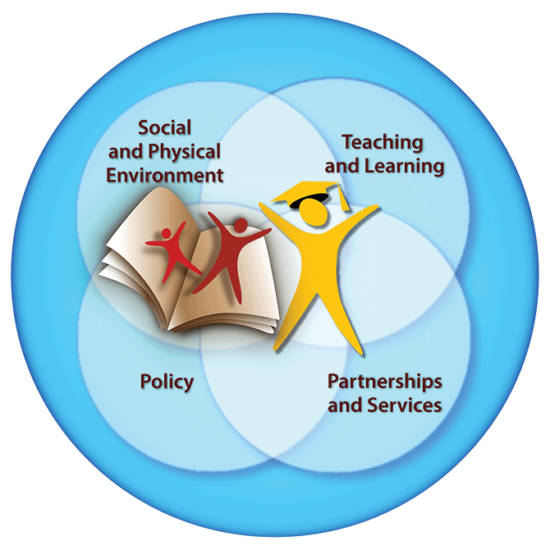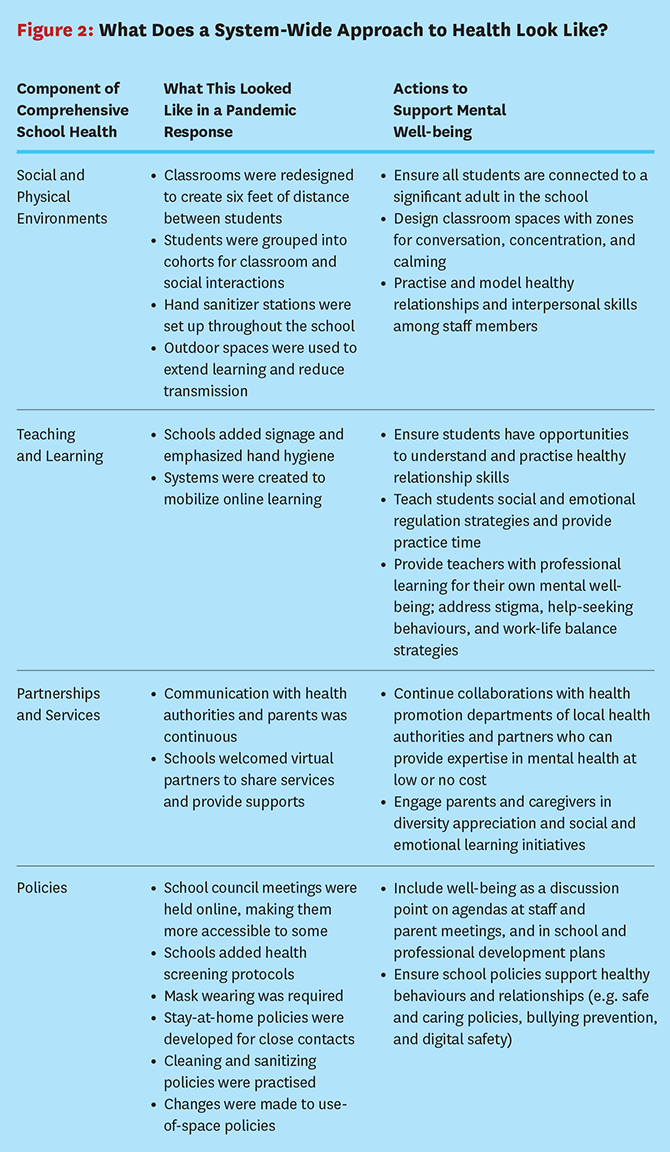Leveraging Pandemic Lessons to Heal
Promoting health in educational spaces
If there is a silver lining to the COVID-19 pandemic, one could argue that it demonstrated the critical role schools play in a functioning society, the interdependence of education and health, and the importance of a whole-school approach to health and well-being. We witnessed schools everywhere do their part in the crisis, going to great lengths to limit viral transmission. Imagine that! Every school in Canada took steps to protect public health that involved home, school, and community, while addressing social and physical environments, policies, teaching and learning, and partnerships and services. This, in essence, is Comprehensive School Health.
Physical health – mask-wearing, sanitizing, and distance between desks – was a dominant educational point for months, but perhaps the school health imperative we now face is the mental well-being of students, teachers, and staff. Can we learn from and leverage the education system’s pandemic response as a template for how to address health in other ways, and not only heal from the impacts of the pandemic, but also promote mental well-being in schools for all stakeholders?
If we ask the right questions now – with intention, compassion, and courage – we can reprioritize the value we place on well-being in school settings. Now more than ever, Comprehensive School Health needs to be on the national education agenda.
Courtesy of the Pan-Canadian Joint Consortium for School Health
Comprehensive School Health: An overview
Wellness is a balance of mind, body, and spirit that results in a feeling of well-being. As part of their social purpose, schools have a fundamental role to play in the well-being of children and youth. It is important to consider the systemic influences and environments in which children and adolescents emerge into adulthood. Young people spend a lot of time in educational contexts. When schools provide health-promoting environments, it creates capacity and opportunity for students to reach their full potential.
Comprehensive School Health (CSH) is gaining recognition among school districts across the globe, and across educational tiers in Canada, for its value in promoting wellness for students, teachers, and other members of the school community (staff, parents, community partners, etc.; Russell-Mayhew & Ireland et al., 2017). The CSH framework, which is based upon the knowledge that health and wellness enhance children’s ability to learn, provides a multifaceted structure for improving wellness within the school community.
Comprehensive School Health is an approach that includes:
- teaching health knowledge and skills both inside and beyond the walls of the classroom
- creating health-enabling social and physical environments
- creating healthy policies
- facilitating links with parents and the wider community to support optimal well-being and learning (Kolbe, 2019).
It is an internationally recognized framework that places students as primary beneficiaries of improved health and learning outcomes through coordinated action with all members of the school community (Koenig & Rodger et al., 2018; Langford & Bonell et al., 2015). This framework is based on evidence that healthy students have increased capacity for learning and that well-being has a positive effect on academic achievement throughout their lifespan (Byrne & Pickett et al., 2016, 2018). Health and education are interdependent. In other words, healthy students are better learners, and better-educated students are healthier (Squires, 2019; Viner & Russell et al., 2020).
A whole-school approach like Comprehensive School Health considers the well-being of the whole student and the whole community. It is not a program or curriculum, it is a process that integrates health promotion into the daily life of the school. The CSH framework takes advantage of a community development approach to enable customization to each unique site and the local context of a school.
Comprehensive School Health across the education system
The CSH framework seeks to harmonize actions across four components:
• teaching and learning
• social and physical environments
• policy and partnerships
• services.
These components guide actions in schools, such as: Ensuring high-quality health education, addressing teacher and staff well-being, revising school development plans to include well-being, and/or increasing social engagement opportunities for students. Ultimately, the CSH framework is intended to foster local autonomy to shift the culture to embrace well-being practices.
Increasingly, teachers are recognized as key agents of socialization, as they occupy positions that allow them to positively influence school wellness and student well-being. Teachers are our most important resource for the well-being of school communities; there is no profession with such profound influence. They influence people, places, and spaces in education. We know that health and education are deeply interconnected and intertwined, so if we want to influence outcomes, we need to focus on the whole person – not just academic outcomes – whether that is faculty, teachers, staff, or students. This includes post-secondary teacher preparation programs, which both serve as a feeder system for, and are an active part of, the education system. Supporting the well-being of pre-service teachers prior to their involvement in K–12 schools is an innovative way to promote transformational systemic change.
The potential cumulative effects of widespread, comprehensive wellness action across educational contexts are exciting to imagine. How might the world be different if every educational space was a place where each student, staff, teacher, and faculty felt a sense of belonging and was able to reach their full potential? What if every school was a healthy school? What if every BEd program was offered in a health-promoting post-secondary context?
So, what now?
We urgently need coordinated strategies that support action at all levels of school governance to address mental health, safety, belonging, and other psychosocial outcomes in schools.
Recasting educational spaces as health-promoting spaces is a systemic change that requires societal support and commitment from across the health and education sectors, as we have recently experienced with the pandemic response. Now we know it is possible, and on a dramatically large scale, too. Comprehensive School Health gives us the framework, and the pandemic gave us the experience. In Figure 2, we explore how schools can leverage their experience of a system-wide approach to health through their pandemic practices into an opportunity for action that supports the mental health and well-being of students, staff, and teachers.
This may seem like a daunting task that is beyond any one individual, and it is. Still, there are small steps we can all take to do our part from both within and outside of the education system to drive change. A good first step is to educate ourselves and others about Comprehensive School Health (see Learn More).
Real and sustainable change is possible if the education system is structured, and supported, to embrace its role in creating health-promoting environments. At their best, education systems can support all children, youth, and young adults to reach their full potential, while ensuring teachers first learn and then work in health-promoting environments to facilitate learning and nurture the well-being of future generations. This type of system-wide embrace of well-being in Canadian education is not just the imaginings of idealists, but was proven possible in the context of the pandemic response.
Education is a human endeavour. In the context of CSH, this means attending to all the ways of wellness – physical, social, emotional, intellectual, spiritual, environmental, and occupational – across educational contexts. The well-being of students, staff, teachers, and faculty is at stake, and we can now better imagine the difference it will make.
Photo: iStock
First published in Education Canada, September 2021
Learn More
For some excellent self-paced learning, check out:
- The Podclass: Conversations on School Health (available on your podcast channel and at https://everactive.org/services/thepodclass)
- Building Healthy School Communities, a free foundational course available online at CSHhub.com
References
Byrne, J., Pickett, K., et al. (2016). A longitudinal study to explore the impact of preservice teacher health training on early career teachers’ roles as health promoters. Pedagogy in Health Promotion, 2(3), 170–183. doi.org/10.1177/2373379916644449
Byrne, J., Pickett, K., & Rietdijk, W. (2018). Teachers as health promoters: Factors that influence early career teachers to engage with health and wellbeing education. Teaching and Teacher Education, 69(1), 289–299. doi.org/10.1016/j.tate.2017.10.020
Koenig, A., Rodger, S., & Specht, J. (2018). Educator burnout and compassion fatigue: A pilot study. Canadian Journal of School Psychology, 33(4), 259–278. doi.org/10.1177/0829573516685017
Kolbe, L. J. (2019). School health as a strategy to improve both public health and education. Annual Review of Public Health, 40(1), 443–463. doi.org/10.1146/annurev-publhealth-040218- 043727
Langford, R., Bonell, C., et al. (2015). The World Health Organization’s Health Promoting Schools framework: a Cochrane systematic review and meta-analysis. BMC Public Health, 15(1), 130–130. doi.org/10.1186/s12889-015-1360-y
Russell-Mayhew, S., Ireland, A., et al. (2017). Reflecting and informing a culture of wellness: The development of a comprehensive school health course in a bachelor of education program. Journal of Educational Thought, 50(2&3), 156-181. www.jstor.org/stable/26372402?seq=5#metadata_info_tab_contents
Squires, V. (2019). The well-being of the early career teacher: A review of the literature on the pivotal role of mentoring. International Journal of Mentoring and Coaching in Education, 8(4), 255-267. doi.org/10.1108/IJMCE-02-2019-0025
Viner, R. M., Russell, S. J., et al. (2020). School closure and management practices during coronavirus outbreaks including COVID-19: a rapid systematic review. The Lancet Child & Adolescent Health. doi.org/10.1016/S2352-4642(20)30095-X


